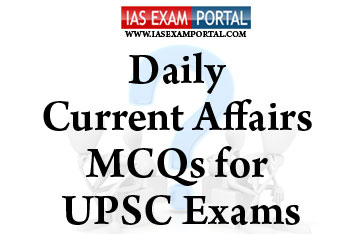Current Affairs MCQ for UPSC Exams - 02 MAY 2019
Q1. Consider the following statements regarding oil imports to India :
1) Iran was India’s second biggest supplier of crude oil after Saudi Arabia
till 2010-11, but western sanctions over its suspected nuclear programme
relegated it to the seventh spot in subsequent years.
2) While U.S lifting of sanctions on Iran recently has led to shifting of Iran’s
position to number two supplier of crude oil to India in 2018-2019.
3) Iraq has, for the second year in a row, become India’s top crude oil
supplier, meeting more than a fifth of the country’s oil needs in 2018-19 fiscal
year.
Which of the above statements are true ?
a) 1 & 2 only
b) 2 & 3 only
c) 1 & 3 only
d) all of the above
Q2. Which of the following national parks in India are also under UNESCO
world heritage sites ?
1) Periyar national park
2) Khangchendzonga national park
3) Jim Corbett national park
4) Keoladeo national park
5) Great Himalayan national park
a) 1,2 & 3 only
b) 2,4 & 5 only
c) 1,3 & 5 only
d) 3,4 &5 only
Q3. Which of the following statements regarding Indian fishing industry are
true ?
1) India is the 2nd largest producer of fish in the world and exports a large
quantity of fish products to various parts of the world.
2) Over the years India’s fishing sector has increased its sources from marine
resources than inland resources for exports.
3) The recently formed Fishing and Aquaculture infrastructure development fund
would help attract private investment in creation and management of fisheries
infrastructure facilities along with employment generation in the sector.
a) 1 & 2 only
b) 2 & 3 only
c) 1 & 3 only
d) all of the above
Q4. With respect to constitution and composition of ward committees under
article 243-S of constitution ,which of the following statements are true ?
1) There shall be constituted Wards Committees, consisting of one or more
wards, within the territorial area of a Municipality having a population of
10lakhs or more.
2) The Legislature of a State may, by law, make provision with respect to the
composition and the territorial area of a Wards Committee and the manner in
which the seats in a Wards Committee shall be filled.
3) Nothing in this article shall be deemed to prevent the Legislature of a State
from making any provision for the constitution of Committees in addition to the
Wards Committees.
a) 1 & 2 only
b) 2 & 3 only
c) 1 & 3 only
d) all of the above
Q5. The National Coastal Zone Management Authority ( NCZMA ) responsible for
protection and improving the quality of the coastal environment and preventing,
abating and controlling environmental pollution in the coastal areas is chaired
by which of the following offices/personalities in India ?
a) Cabinet secretary
b) Secretary, Ministry of environment & forests
c) Chairman of central water commission ( CWC)
d) Prime minister


